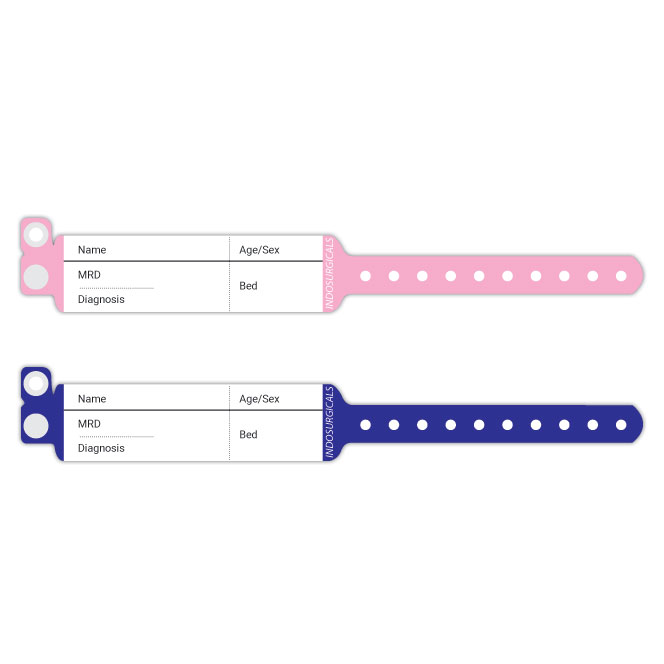Checking Out the Various Sorts Of Patient Identification Band Made Use Of in Medical Facilities
In the elaborate globe of healthcare, the crucial duty of Patient Identification bands often goes undetected. These bands, varying from straightforward paper wristbands to advanced RFID bands, develop the foundation of Patient safety and security methods, making certain precision in Patient Identification.
Comprehending the Value of Patient Identification Bands
While they might seem like simple devices, Patient Identification bands play an important duty in medical facilities. These bands serve as an important tool for confirming Patient identity, stopping clinical mistakes related to misidentification. Patient Identification bands also aid in simplifying administrative tasks, guaranteeing exact record-keeping and billing.
Conventional Paper Wristbands: Their Usage and Limitations
Standard paper wristbands have been a staple in Patient Identification across various medical centers. While their use is prevalent, they nurture certain limitations that might affect their effectiveness in Patient monitoring. This area will certainly concentrate on the range of their application and the intrinsic downsides linked with their use.
Paper Wristbands: Usage Scope
In the world of Patient Identification, paper wristbands have long held a vital function. These bands are typically made use of in outpatient setups, where the Patient's keep is short-term. In spite of advancements in technology, the simple paper wristband continues to be a reputable and cost-effective service for Patient Identification in different healthcare situations.
Limitations of Paper Wristbands
In spite of their extensive usage, paper wristbands are not without their downsides. In enhancement, paper wristbands usually lack the technical capacities of more modern-day options, such as barcoding or RFID chips, limiting their performance to just presenting composed details. Paper wristbands can trigger pain or skin irritation to some patients, particularly when put on for extensive periods.
Barcoded Wristbands: Advancements in Patient Identification
While Patient Identification has long been an important element of health care, the arrival of barcoded wristbands symbolizes a considerable leap forward. These bands take advantage of the simpleness of barcoding modern technology, allowing for Patient details to be swiftly checked and accessed. They boost the rate and accuracy of Patient Identification, lowering the risk of medical errors connected to misidentification. Barcoded wristbands are cost-effective, very easy to generate, and remove handwriting errors typical with hand-operated systems. Nonetheless, they are not without restrictions. While they supply renovations over traditional bands, the barcode can come to be smudged or worn, providing it unreadable. Regardless of this, barcoded wristbands continue to be an important tool in contemporary healthcare settings, signifying the junction of modern technology and Patient treatment.
Radio Frequency Identification (RFID) Bands: an Action Towards Futuristic Medical Care
The development of Patient Identification bands has produced the introduction of Superhigh frequency Identification (RFID) Bands (patient identification band). These innovative gadgets present essential benefits for medical care facilities, providing a much more effective and highly progressed means of Patient Identification. The application of RFID in healthcare is a substantial step towards a more advanced strategy to Patient monitoring and safety
Recognizing RFID Bands

RFID Bands: Trick Advantages
Largely, these bands boost Patient security by supplying accurate, immediate Identification, consequently decreasing clinical mistakes. RFID bands can store a substantial amount of Patient data, consisting of clinical history and allergies, allowing individualized care. In general, RFID bands stand for a substantial advancement in Patient Identification modern technology, profiting both patients and health care carriers.
Implementing RFID in Healthcare
As we step into a technically innovative period, the execution of RFID bands in healthcare becomes increasingly vital. These bands offer a seamless method to track and determine clients, ensuring their security and enhancing effectiveness in treatment procedures. RFID bands provide various advantages over conventional Identification methods. They can store a vast amount of information, consisting of the Patient's clinical history and treatment plans, which can be conveniently accessed by medical care suppliers. This data assists medical professionals make notified decisions pertaining to the Patient's therapy strategy. In addition, RFID bands minimize medical errors by offering accurate Patient Identification, which is important in preventing misdiagnosis or incorrect medicine management. Hence, the execution of RFID bands is a considerable step towards improving Patient safety view it now and medical care distribution.

Color-Coded Wristbands: Helping in Quick and Accurate Medical Diagnosis
In the dynamic atmosphere of a clinical center, color-coded wristbands have become crucial devices for swift and accurate Identification of a client's medical condition. These wristbands, put on by individuals, bring particular colors that represent various medical conditions or statuses. For example, red could show allergic reaction dangers, while yellow may symbolize an autumn risk. This system is created to use instant aesthetic cues to healthcare companies, enhancing Patient security and care quality. In emergency situation situations, the usage of these wristbands enables quick decision-making. The efficiency of color-coded wristbands depends on the harmony of color analysis across health care institutions, needing common criteria for constant application.
Approaches for Efficient Implementation and Administration of Patient ID Bands
Achieving optimal use Patient Identification bands requires a well-structured method for their execution and monitoring. The primary step includes training all health and wellness employees on the relevance of correctly applying and reading these bands. Healthcare facilities must systematize the usage of ID bands across all departments, making sure harmony and minimizing inconsistencies. Routine audits Full Report ought to be carried out to confirm adherence to policies and to rectify any kind of incongruities. Patient education and learning is likewise vital; people have to recognize the function of the bands and the need for their constant wear. patient identification band. Last but not least, it's necessary to have a back-up strategy in position, such as barcode scanning or biometrics, to ensure that Patient Identification is never compromised.
Final thought
Patient Identification bands are important in clinical original site facilities to make sure safety and accuracy. Efficient execution and monitoring of these bands can considerably minimize clinical mistakes, boost effectiveness, and enhance total Patient care.
These bands, varying from basic paper wristbands to advanced RFID bands, form the backbone of Patient safety and security protocols, making sure accuracy in Patient Identification.The evolution of Patient Identification bands has brought regarding the appearance of Radio Regularity Identification (RFID) Bands. Overall, RFID bands represent a significant development in Patient Identification technology, benefiting both clients and health care providers.
RFID bands decrease medical errors by providing accurate Patient Identification, which is critical in preventing misdiagnosis or incorrect medication administration. Patient education is additionally crucial; patients should understand the purpose of the bands and the need for their consistent wear.